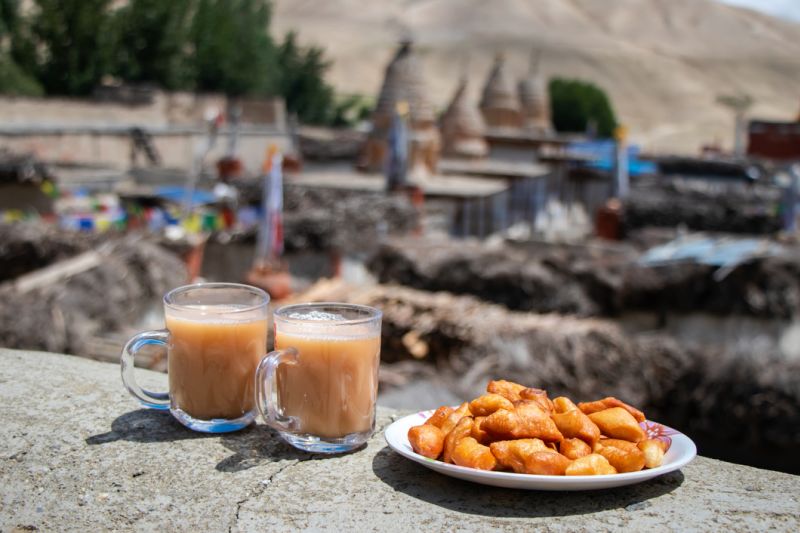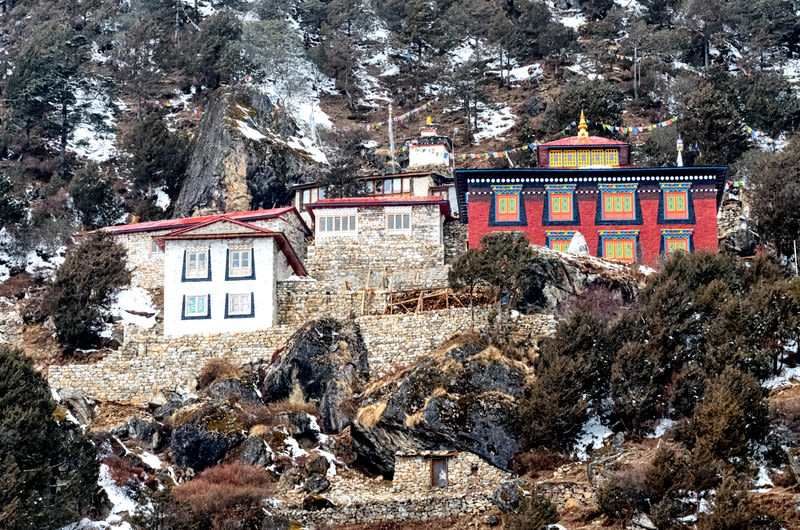Altitude sickness is a condition that occurs when your body cannot adapt to the low oxygen levels and atmospheric pressure at high elevations. The most common symptoms are headache, nausea, fatigue, dizziness, shortness of breath, loss of appetite and difficulty sleeping.
In severe cases, altitude sickness can lead to pulmonary oedema (fluid in the lungs) or cerebral oedema (swelling of the brain), which can be fatal if not treated promptly.
It's therefore absolutely essential to acclimatise properly before and during any trek in the mountains of Nepal.
Our clients Bryan and Nikki on the Langtang Valley trek in spring 2023
Acclimatisation is the process of allowing your body to adjust to the new elevation gradually.
Proper acclimatisation = little or no altitude sickness!
Here are seven steps to take to acclimatise properly for a high-altitude trek in Nepal ...
1. Start low and go slow
The most important and effective way to prevent altitude sickness is to ascend slowly and steadily.
The Upper Mustang region of western Nepal
The higher you go, the less oxygen there is in the air. Your body needs time to start producing more red blood cells and increasing your breathing rate to compensate for the oxygen deficiency.
If you ascend too fast, you deprive your body of the time necessary to adapt, and it will react badly.
Therefore, you should follow this rule of thumb, or something near to it, when trekking in the Himalayas:
- Don't increase your sleeping altitude by more than 300 to 500 metres per day.
- Take a rest day every 1,000 metres or so.
For example, if you start your mountain trek at 2,800 m above sea level (asl), you shouldn't sleep higher than 3,300 m on that first day, and you should take a rest day at 3,800 m.
Most folks heading to Everest Base Camp spend two nights in Namche Bazaar (3,440 m asl)
That said, if you're an experienced high-altitude trekker, or live at an extreme elevation, there's a good chance this rule of thumb won't apply to you. Experience will tell you how much you can deviate from it.
2. Climb high and sleep low
Another useful strategy for proper acclimatisation is to climb high and sleep low. This means hiking to a higher elevation during the day but returning to a lower elevation for the night.
The climb-high-sleep-low practice exposes your body to higher altitudes for a short period of time, which stimulates your acclimatisation process, but then allows it to recover at a lower altitude, which reduces your risk of developing altitude sickness.
Manang is a regular acclimatisation stop for those on the Annapurna Circuit
For example, if you slept at 4,000 m asl the night before, you could hike up to 4,500 m during the day but then come back down to 4,000 m or thereabouts for the night.
One of the popular ways to incorporate the climb-high-sleep-low strategy is to include a roundtrip day hike into your trekking itinerary. On the Annapurna Circuit, for instance, many trekkers spend two or even three nights in the town of Manang and do day hikes that can take them up to even 1,000 m higher.
The Ice Lakes is a popular roundtrip acclimatisation hike on the Annapurna Circuit
3. Stay hydrated
Drinking plenty of fluids is essential for acclimatisation. Dehydration can worsen the symptoms of altitude sickness and impair your performance.
Lodges in the Himalayas always offer soup
You should drink at least three or four litres of water per day while trekking in Nepal. You can also drink herbal tea, juice and soup to replenish your fluids and electrolytes.
4. Eat well
Eating well is also important for acclimatisation. You need enough calories and carbohydrates to fuel your body and maintain your energy levels.
You need lots of energy just to exist at high altitude, let alone trek
Carbohydrates are easier to digest and metabolise at high altitudes than fats or proteins.
You should eat small and frequent meals that are rich in carbohydrates, such as rice, pasta, bread or fruits.
Carbohydrates are essential when trekking in the cold at altitude
Please note that loss of appetite is a common side effect of ascending to high altitude. It's important to still make yourself eat full meals even if you don't feel like it.
5. Avoid smoking, caffeine and alcohol
You should avoid smoking, as it reduces the amount of oxygen in your blood, which will make acclimatising that much harder.
You should avoid alcohol and caffeine when trekking at altitude, as they can both dehydrate you and interfere with your breathing pattern.
You need to have a clear mind when trekking at potentially dangerous altitudes
That said, you don't want to undergo caffeine withdrawal during your trek, so consider weaning yourself off of it beforehand. Or at least reduce your intake to perhaps one morning cup?
Finally, remember that alcohol can also impair your judgement, making you less mentally sharp and physically responsive. Not good!
6. Take medication if necessary
If you have a history of altitude sickness or a medical condition that makes you more susceptible to it, you may consider taking medication as a preventive measure. In fact, some folks who aren't familiar with altitude sickness take altitude meds just in case. We're not saying we recommend this – we're saying it might be a good idea to talk with your doctor about the idea.
On the Everest Base Camp you spend a night at 5,164 m asl!
The most common medication for altitude sickness is acetazolamide (Diamox is a well-known brand). It helps your body to breathe faster and more efficiently at high altitude.
That said, please note that acetazolamide can have some side effects such as a tingling sensation, nausea, drowsiness or even an allergic reaction. So you should always stick to the prescribed dosage.
7. Listen to your body and descend if necessary
The most important thing to remember while trekking in Nepal is to listen to your body and be honest with yourself. Don't push yourself beyond your limits or ignore the signs of altitude sickness.
A section of the beautiful Manaslu Circuit
If you feel unwell or notice any symptoms of altitude sickness, you should stop ascending immediately and rest until you feel better. If your symptoms don't improve (or worsen within 24 hours), you should descend as soon as possible to a lower altitude where you can get medical attention.
Descending is the only definitive treatment for altitude sickness and can save your life.
Always listen to your guide's advice concerning altitude sickness
Finally, as it's now mandatory to trek with a guide in Nepal, be sure to listen to the advice of your guide, as they're trained to detect the early warning signs of serious altitude sickness.
Enjoy your trek in Nepal
We hope this blog post has given you some useful information on how to acclimatise when trekking in Nepal. If you follow these tips and the advice of your trek guide, you should be able to enjoy your Nepal adventure without any qualms or problems.
That said, if you have any questions or concerns, please don't hesitate to contact us!
Lastly, if you're keen to trek in Nepal but aren't sure what trail you should choose, you might enjoy our Nepal trekking guide: Where to trek on your Nepal trip.
The historic Kunde Monastery in the Everest region


















